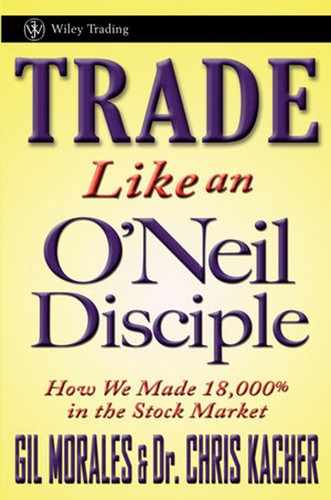3.6. CLEARED FOR TAKE-OFF
Once the general market followed through in late October, Oracle broke out of this second base, as Figure 3.9 shows, and this was the correct time to make the trade. All the conditions had lined up properly so that the "line of least resistance" was properly penetrated, and the stock was free to begin its price climb.
Figure 3.10. ORCL's breakout from the base-on-base formation results in a sharp upside move into the end of 1999.: Chart courtesy of eSignal, Copyright 2010

The weekly chart of Oracle in Figure 3.10 shows the volume support on the first week down in the second base of the base-on-base formation, as I've labeled. This is the type of volume support clue that can show up on the weekly and daily charts and which should always be watched for. This clue, combined with the strong base-on-base formation that essentially "hugged" the 10-week or 50-day moving average was highly constructive as I saw it, and I began taking a partial position as the stock was working on the sixth week of this second base. When the market followed through and Oracle broke out through the top of this second base the stock was off to the races.
By mid-November 1999, Oracle had just about doubled, and I was riding a nice wave at the time. The daily candlestick chart of Oracle in Figure 3.11 shows this move in November. The small black triangles that start showing up on the chart indicate days where the stock was, at those points, trading up 12 out of 15 days in a row, and you will notice that Oracle showed this indicator for 12 days in a row before it finally started its first decent pullback and consolidation. The key here is that when a stock is up 12 out of 15 days in a row or better, it is showing exceptional upside thrust, and once the stock begins to consolidate this sharp upside move after breaking out of a proper base, it must be watched for another move and "breakout" to new highs, as this is a point where one should be willing to add to the position aggressively. In addition to the 12 out of 15 days in a row or better in the initial uptrend off the late October breakout, the stock had also dipped below its 10-day moving average where it found support at its 20-day moving average. When Oracle cleared this little three-week consolidation it flashed a second major buy point and so at this point it was possible to add stock aggressively, which enabled me to ride the ensuing move through December right up into the year-end peak.
Figure 3.11. Oracle Corporation (ORCL) daily candlestick chart gives a buy signal on a key pullback during the stock's price run in late 1999.: Chart courtesy of eSignal, Copyright 2010

